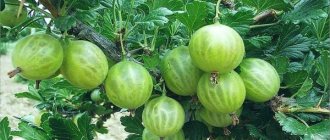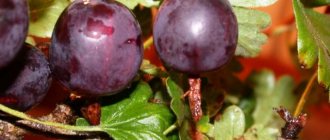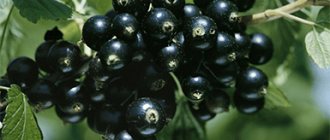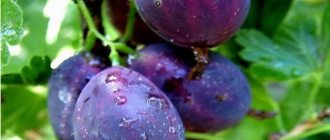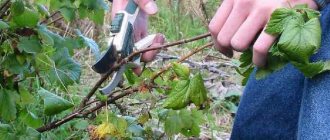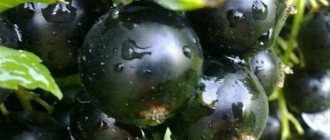History of variety development
The gooseberry variety Harlequin with attractive red berries is the result of breeding work by employees of the South Ural Research Institute of Horticulture and Potato Growing. Its author, V.S. Ilyin crossed the Chelyabinsk green and African gooseberry varieties. The new variety of gooseberries has been tested in plantings since 1989, and 6 years later it was included in the State Register with recommendations for cultivation in the Ural and Western Siberian regions.
Gooseberry Harlequin: reviews from gardeners about the variety
- Natalya Viktorovna, Voronezh region: “At one time I chose the gooseberry variety Harlequin for cultivation because of its self-fertility. I didn’t really want to grow other gooseberry varieties nearby. What can I say after 10 years of cultivation: the branches of the Harlequin gooseberry variety have weak thorns, which simplifies harvesting, and the variety itself tolerates both drought and frost. Harlequin gooseberries are not only tasty, but also have an excellent presentation. I definitely recommend growing Harlequin gooseberries in your garden!”
- Victoria Mikhailovna, Sverdlovsk region: “The Harlequin gooseberry, unfortunately, is not the most productive variety among all the gooseberry varieties I know. Although the berries are very tasty. Also, despite the fact that the characteristics of the variety include its good immunity to many diseases, my Harlequin gooseberry was affected by the insidious septoria.”
Description of the bush and berries
The medium-sized Harlequin gooseberry bush has straight, medium-spreading branches. Slightly spiny shoots without pubescence, light green. Weak, short and thin spines of a single type are found only on some shoots at the nodes. Three- and five-lobed leaves with blunt teeth are slightly larger than average in size, with fine pubescence, moderately wrinkled and slightly shiny. In overgrowing shoots, the base of the leaf has a small notch or is straight. Small, brown buds with a pointed tip deviate from the branch.
The inflorescence of the variety contains 2-3 small bright flowers with long pink or light red bent sepals. The peduncle is dark green.
The round-oval, uniform berries of the Harlequin gooseberry variety are deep dark cherry in color; in the full ripening phase, they weigh from 2.7 g to 5.4 g. The skin is of medium density and has no pubescence. The pulp is sweet and sour, juicy, thick, and starchy in the phase of full maturity. 100 g of gooseberry berries contain 24.4 mg of ascorbic acid. The berries contain 6.6% sugar, 3.3% acid, 12.3% dry matter. According to the All-Russian Research Institute for Breeding Fruit Crops, the tasting score of Harlequin gooseberries is 4.8 points.
Advantages and disadvantages
| Advantages | Flaws |
| Self-fertility (38.9%) | Average yield compared to new varieties. For sufficient berry picking, 3-4 plants should be planted |
| Branches of the Harlequin variety are weakly thorny | The berries have a mediocre taste; they are recommended to be processed |
| Commercial attractiveness of berries | Late ripening |
| Resistance of the Harlequin variety to frost and drought, easy care | |
| Powdery mildew resistance | Susceptibility to septoria |
Important! Water the Harlequin gooseberry abundantly so that the earthen ball with all the roots is moistened.
Advantages and disadvantages
In most cases, even a novice gardener can cultivate Harlequin gooseberries on a plot. However, this often ends in complex problems. A rigorous study of the main advantages and disadvantages of the variety will help you avoid them.
Drought resistance, frost resistance
This plant can be called one of the most unpretentious and resistant to all kinds of weather conditions. Harlequin tolerates almost any seasonal cold snap in the recommended growing area, as well as summer drought.
However, in extremely cold climatic zones, the berries may not ripen completely, which immediately reduces the quality of the harvest.
Productivity and fruiting
Harlequin is characterized by friendly fruiting, self-fertility and good yield , while the berries are of excellent commercial quality. However, the fruits are unsuitable for fresh consumption, and the yield indicator is often significantly inferior to more modern hybrids.
Find out more about when gooseberries begin to bear fruit after planting seedlings.
In addition, the yield of the variety depends sharply on the appearance of the pathogen Septoria on the site, to which Harlequin has no natural immunity.
Characteristics
| Criteria | Data |
| Productivity | From 1 square meter 0.4 kg of berries are harvested. At variety testing stations, gooseberries yielded up to 8 tons per hectare. On average, over the years of testing, from 1992 to 1994, the Harlequin variety showed a yield of 38.0 c/ha. |
| Drought resistance | Gooseberries tolerate short dry periods, but this variety requires sufficient moisture to form berries. |
| Winter hardiness | The Harlequin variety bush tolerates temperatures of -35°C. In frosty winters the tops freeze. The shoots recover well and bear fruit. Resistant to spring temperature changes |
| Resistance to diseases and pests | The Harlequin variety is not affected by powdery mildew and is susceptible to white leaf spot. Sawfly larvae eat tender gooseberry leaves |
| Maturation period | Late. In the European part of Russia, the Harlequin variety will ripen by the end of July, in Siberia - in August |
| Transportability | The dense structure of the berries endures transportation |
Advantages and disadvantages of the variety
The key advantages of culture include the following:
- resistance to fungal infections;
- low maintenance requirements;
- frost resistance;
- minimum number of spikes;
- excellent transportability;
- long storage period.
See also
Description of Finnish gooseberry varieties, cultivation and propagationRead
At the same time, culture also has certain disadvantages:
- not too high yield;
- insufficient resistance to septoria and sawfly attacks;
- pronounced sourness in taste.
Landing Features
Harlequin gooseberries are planted in spring and autumn. Autumn planting at the end of September is preferable, since the buds of the bush wake up early. Gooseberries planted in spring may take a long time to take root and will weaken. Bushes of the Harlequin variety with predominantly erect shoots are placed at intervals of 0.8-1.2 m, providing sufficient insolation and ventilation. When choosing a seedling, pay attention to the presence of a branched root system. The shoots are healthy, without wounds on the bark.
- Prepare a hole 0.7 m wide and deep.
- A drainage of gravel, pebbles, small fragments of bricks is placed at the bottom and covered with sand.
- For the substrate, fertile soil is mixed with 8-10 kg of humus or compost, 5 kg of sand on heavy soils, 200 g of wood ash and 100 g of nitrophoska or a mineral complex for berry bushes.
- Gooseberry roots are laid out on a mound of substrate at a depth of 60 cm and the root collar is sprinkled.
- The soil is compacted, watered, and mulch of humus or peat is placed on top.
Attention! In autumn, seedlings are planted high, protecting them from frost.
Time, place and landing pattern
Plant Consul in the period starting from the first half of March, as soon as the last snow melts, or in early autumn, about 30 days before the first low temperatures. Try to plant the plant immediately after purchase, because it is unknown how long the seedling was left without soil.
Consul gooseberry planting scheme:
soak the seedlings for a day before planting in a growth-stimulating substance; plant gooseberry bushes at a distance of at least 1.5 m; dig holes with a diameter and depth of 50-60 cm; pour peat or a small amount of humus onto their bottom; add fertilizer - 50 g each of potassium salt and superphosphate; remove dead shoots on the seedling, if any, and cut the branches by a third; When planting a seedling, carefully straighten its roots - while deepening the root collar by 6 cm; fill the depression with earth and compact it;
cover the soil at the roots with straw, sawdust or pine needles; Water the planted shrub well with water.
Next, water the Consul, rid the soil of weeds, and remove diseased and dry branches. The planting site must be protected from drafts and well lit, otherwise the berries will ripen unevenly and very slowly.
Rules of care
The undemanding Harlequin gooseberry variety requires minimal care.
Support
After planting, make a support for the branches of the bush. The structure is constructed from wooden beams, metal-plastic pipes, acquiring the necessary fastenings. It prevents branches from accidentally bending towards the ground.
Top dressing
Harlequin gooseberry bushes are given mineral and organic fertilizers. They are used after watering.
- Immediately after the snow melts, 200 g of wood ash and 40 g of nitrophosphate are scattered onto the wet ground in a circle around the tree trunk.
- Before flowering, fertilize with 500 g of mullein or 200 g of bird droppings diluted in 10 liters of water. 50 g of potassium sulfate and ammonium sulfate are added to the organic matter. For young bushes 3 liters is enough, for adults twice as much.
- The same mixture or nitrophoska is fertilized in the phase of ovary formation.
- In the fall, once every 2-3 years, 10-15 kg of humus is poured under the bush.
Bush pruning
Old branches that have reached 5 years old are removed from the gooseberry bush of the Harlequin variety in spring or autumn. The remaining branches are cut off by 10-15 cm from the top. Damaged, frozen shoots or shoots heading into the bush are removed.
Reproduction
The gooseberry variety Harlequin is propagated by layering and dividing the bush.
Near a healthy branch that is located low, dig a groove 10-15 cm deep and lay the branch using garden pins. The place of cuttings is constantly watered, stimulating the formation of roots and shoots. Sprouts that have reached 10-12 cm are spudded. In September, the seedlings are moved.
In the fall, they dig up a large bush and divide the root with a sharp ax. The transplanted divisions are spudded.
Preparing for winter
Having collected fallen leaves, dig up the soil to 10 cm. Add a 12 cm layer of humus or peat, which is removed from the bush in the spring. Sawdust is sometimes added to humus.
Harvesting and storage
The harvest ripens in late July and early August. It is recommended to pick berries by hand. This is best done in dry and cloudy weather. The harvest can be stored at a temperature of +5 degrees for 10 days. If longer storage is required, it is recommended to freeze the berries .
Harlequin gooseberry is considered a popular plant. Its fruits are actively used for various preparations. In order for the plant to develop normally and produce a full harvest, it must be properly cared for.
Disease Control
| Disease | Signs | Control measures | Prevention |
| White spot or septoria | The leaves have grayish spots with a dark border. Later, black dots with spores form on the spots. Leaves curl, dry, fall off | Affected leaves are removed. Treatment with 1% Bordeaux mixture before and after flowering, then after 2 weeks and after picking the berries | In autumn, fallen leaves are removed. In early spring, spray 40 g of copper sulfate per 10 liters of water. Boron, manganese sulfate, zinc, copper are added to the soil under the bushes |
| Anthracnose | Dark brown spots on leaves that dry out and fall off. Young shoots grow weakly. The berries are sour. The harvest is declining | Spraying with 1% Bordeaux mixture, as for septoria | Fallen leaves are removed. In spring, treat with copper sulfate |
| Viral gooseberry mosaic | There are yellow spots in a pattern along the leaf veins. The leaves grow small. Shoots do not grow, yield decreases | There is no treatment. Bushes are removed and burned | Healthy seedlings. Fighting aphids and mites that spread the disease |
Pests and diseases
The Belarusian sugar gooseberry variety is characterized by high immunity to various diseases.
To prevent diseases, the old layer of mulch is removed with the arrival of spring, after first watering the bush with hot water (3 - 5 l). The old layer is replaced with a new one. An additional preventive measure is to treat the soil under the bush with a 1% solution of Bordeaux mixture. The procedure should be performed before the buds open. Before the formation of buds begins, the bush is treated with Karbofos. This will protect the plant from insects such as aphids, gall midges and sawflies. You can get rid of kidney mites using colloidal sulfur (30 g per 10 liters of water).
Pest Control
| Pests | Signs | Control measures | Prevention |
| Gooseberry sawfly | The appearance of small, up to 6 mm, insects with a shiny black body and membranous wings. The larvae, greenish caterpillars, eat the leaves. The berries are small, the bush weakens, does not tolerate winter | Manual collection of caterpillars, infusions of wormwood, garlic, tobacco | Digging the soil in autumn, loosening in summer, collecting fallen berries |
| Aphid | Colonies on the tips of the shoots, the upper leaves are curled into a ball | Treatment: Iskra, Fufanon, infusions of soap, garlic | In early spring they pour boiling water over the bushes |
How to propagate the variety?
Consul can be propagated in two ways:
- Using cuttings. Cut the plant from July to autumn, cutting off an oblique part of the branch about 15 cm long. The cut cuttings must have at least a couple of buds. Then treat the cuttings with substances that enhance the growth of the root system, and place the shoots at an angle of 45 degrees in loosened soil so that 2-3 buds remain above the ground. Next, simply water the plant.
- By layering. In this case, bend the annual shoots to the ground, and then secure them with a metal bracket and sprinkle with soil. Systematically water the shoots, and when young branches appear on them, separate the seedling from the mother plant.



